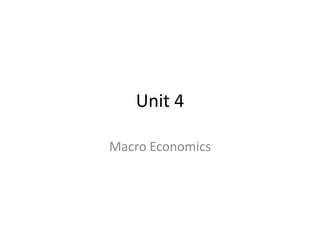
Unit 4 macro eco
- 2. Introduction • Great depression of 1920-40 has brought the significance of creating Macro Economics. • Macro Economics as a separate branch of Economics came in 1936 by John Keynes publications. • It led for the emergence of Keynesian revolution to meet the need of modern day economies.
- 3. Keynesian Theory • It states that employment is a function of income. • Employment & Income is determined by the level of effective demand, national income, interest rates, consumption etc… • But in a country, inflationary & deflationary gaps exists which prevents the growth of economy.
- 4. Inflationary & Deflationary Gap • Inflationary gap occurs when consumption & investment expenditures are greater than the full employment, this gap arises. • Here consumer demand for goods & services are greater than its supply. • Hence under this condition NI, output, employment cannot be increased further. • Where as Deflationary Gap occurs when total demand fails to create full employment.
- 5. Macro Economics • Samuelson defines Macro Economics as “the study of thee behaviour of the economy as a whole. It examines the overall level of a nation’s output, employment, prices and foreign trade”. • In simple words, Macro economics theory is the theory of income, employment, prices and money.
- 6. Static & Dynamic economies • In a Static economy, normal economic activities go on but there is no change in the size of economy, national output, stock of capital, prices, technology, population taste & preferences, nature of business & employment. • In a Dynamic economy, the country will always be in motion, forces of change are instant & simultaneous.
- 7. Employment model • The classical employment model consists of two components. They are: 1. Aggregate production function 2. Labour supply & demand function • These components display the real output & employment required to produce equilibrium level of national output under the given money supply.
- 8. Aggregates under Keynesian model • Aggregate supply function • Aggregate demand function • Aggregate consumption function • Aggregate saving function • Investment
- 9. • Aggregate supply function is the total supply of goods in the economy. In SR, it is the function of number of labour reqd for prodn. • Aggregate demand function depends on demand for consumer goods & investment goods in a two sector economy. • Aggregate consumption function is the consumption expenditure of household depends upon the income of the household. • Investment happens in the three sector economy.
- 10. Circular flow of money • Flow of money can happen in different sectors of the economy. They are: 1. Two sector economy – consists of Firms & households. 2. Three sector economy – consists of Firms, households & Government. 3. Four sector economy – Firms, households, Government & International markets.
- 11. Theory of Interest • Interest is the opportunity cost of holding money. • It is the premium which has to be offered to induce people to hold their wealth in some form other than hoarded (accumulated) money. • Rate of interest is determined by demand for and supply of money. • The desire of people to hold money is called liquidity preference. • Money is held for meeting various transaction, precautionary and speculative motives.
- 12. Macro economic problems • Overall Growth rate of the economy • Unemployed labour force • People living below poverty line • Inflation • Balance of payment • Fiscal & monetary policies • Industrial development • Balanced sectoral development etc..
